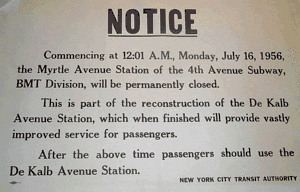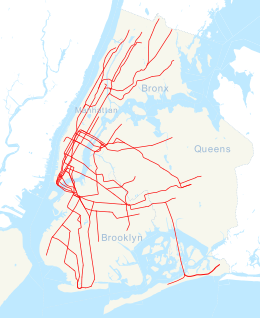Myrtle Avenue station (BMT Fourth Avenue Line)
Myrtle Avenue was a local station on the Manhattan Bridge subway tracks (B, D, N, and Q trains) south of the bridge in Brooklyn, New York City, United States.
Myrtle Avenue | |||
|---|---|---|---|
| Former New York City Subway station | |||
 Notice of the closing of Myrtle Avenue | |||
| Station statistics | |||
| Address | Flatbush Avenue Extension & Myrtle Avenue Brooklyn, NY | ||
| Borough | Brooklyn | ||
| Coordinates | 40.6937°N 73.9833°W | ||
| Division | B (BMT) | ||
| Line | BMT Fourth Avenue Line | ||
| Services | None (abandoned) | ||
| Structure | Underground | ||
| Platforms | 1 side platform (2 when station was open) | ||
| Tracks | 5 (4 when station was open) | ||
| Other information | |||
| Opened | June 22, 1915[1] | ||
| Closed | July 16, 1956 | ||
| Former/other names | Gold Street | ||
| Station succession | |||
| Next north | Canal Street (via Broadway Line) Grand Street (via Sixth Avenue Line) | ||
| Next south | DeKalb Avenue | ||
| |||
| |||
History
This station opened on June 22, 1915, along with the rest of the BMT Fourth Avenue Line.[1]
The station closed on July 16, 1956 for the reconstruction of the flying junction north of DeKalb Avenue to increase capacity for the entire BMT Division.[2] The Brooklyn-bound platform was removed completely, but the Manhattan-bound platform still exists.[3]
This station was a casualty of the rebuild. A new track had to be added on the west side to allow for a grade-separated crossing. The original southbound "local" track at the platform had to be depressed to a lower grade to cross under, and the new track wiped out the southbound platform. The northbound platform was left in place but no longer operated for passenger service.
There was a plan to build a loop just north of this station to turn back Fourth Avenue local trains from 95th Street. The bellmouths for the un-built loop can be seen just north of this station where the bypass tracks join the bridge tracks that stop at DeKalb Avenue.
Myrtle Avenue station was sometimes called Gold Street in some early planning documents,[2] and in the Brooklyn Daily Eagle when the station opened.[1]
The entrance to the station was from the inside of a building, and after the station was closed up, the connection was blocked off with a cinderblock wall. In 2007, the City allowed a developer that purchased the block above the station to demolish the access point to the station. A thick concrete wall now exists at the entrance to the platform.[4][5]
Masstransiscope
In 1980 the Masstransiscope zoetrope artwork by Bill Brand was installed in the station.[6] The artwork consists of 228 hand-painted panels that are behind a long slit light box. The artwork stretches for the full 300 feet of the platform.[7] On September 17, 1980, passengers could start seeing the completed work from trains.[8] This allows riders on the Manhattan-bound B and Q trains (and D trains during late nights when they stop at DeKalb Avenue) right before the bridge to look to their right and experience the illusion that the paintings are moving.[9] By the mid-1980s, despite Brand's efforts to maintain the artwork, it fell into a state of disrepair. It was briefly repaired in about 1990, but it was soon covered in graffiti.[10] After falling into a state of disrepair, graffiti was removed in 2008 and the artwork restored.[11] Masstransiscope was again covered by graffiti during the complete subway shutdown during Hurricane Sandy[12] and again restored after that.[6]
Originally, Brand came up with a more ambitious plan using blown up photographs to create a virtual film strip–these would have been regularly swapped out.[10]
Station layout
| G | Street Level | - |
| P Former platform level |
Side platform, not in service | |
| Northbound local | ← (No service: Grand Street (Sixth Avenue) or Canal Street (Broadway)) | |
| Northbound express | ← | |
| Southbound express | → | |
| Southbound express | → | |
| Southbound local | → (No service: DeKalb Avenue) | |
When open, this underground station had four tracks and two side platforms.
References
- "Through Tube to Coney, 48 Minutes: First Train on Fourth Avenue Route Beats West End Line Eleven Minutes". Brooklyn Daily Eagle. June 22, 1915. Retrieved June 29, 2015.
- Joseph Brennan (2002). "Abandoned Stations : Myrtle Avenue". Retrieved September 9, 2010.
- "BMT Fourth Avenue Line - Myrtle Avenue". nycsubway.org. Retrieved September 9, 2010.
- "Myrtle Ave Abandoned Station and Mezzanine". LTV Squad. September 3, 2005. Retrieved May 7, 2017.
- "Myrtle Ave. station lost to time, development". Second Ave. Sagas. March 14, 2007. Retrieved May 7, 2017.
- mtainfo (August 28, 2013), Reinstalling Masstransiscope, retrieved May 7, 2017
- "MTA - Arts & Design | NYCT Permanent Art". web.mta.info. Retrieved May 7, 2017.
- "Hollywood Under Myrtle Avenue". New York Daily News. September 23, 1980. Retrieved November 5, 2018.
- "Brooklyn Heights Subway track map". nycsubway.org. Retrieved September 9, 2010. External link in
|publisher=(help) - Kennedy, Randy (December 31, 2008). "Restored Brooklyn Subway Art Offers Trip to 1970s". The New York Times. ISSN 0362-4331. Retrieved May 7, 2017.
- Bill Brand. "Masstransiscope". Archived from the original on October 5, 2010. Retrieved September 9, 2010.
- "The Newly Vandalized Masstransiscope". Archived from the original on October 10, 2016. Retrieved August 29, 2013.



%26groups%3D_4a38c4c2781409905e0c203b71abbfd48e0a146d.svg)